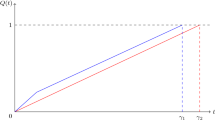Abstract
We consider the problem of estimating tail probabilities of waiting times in statistical multiplexing systems with two classes of sources – one with high priority and the other with low priority. The priority discipline is assumed to be nonpreemptive. Exact expressions for the transforms of these quantities are derived assuming that packet or cell streams are generated by Markovian Arrival Processes (MAPs). Then a numerical investigation of the large-buffer asymptotic behavior of the the waiting-time distribution for low-priority sources shows that these asymptotics are often non-exponential.
Similar content being viewed by others
References
J. Abate, G.L. Choudhury, D.M. Lucantoni and W. Whitt, Asymptotic analysis of tail probabilities based on the computation of moments, Ann. Appl. Probab. 5 (1995) 983–1007.
J. Abate, G.L. Choudhury and W. Whitt, Asymptotics for steady-state tail probabilities in structured Markov queueing models, Comm. Statist. Stochastic Models 10(1) (1994) 99–143.
J. Abate and W. Whitt, Approximations for the M/M/1 busy period, in: Queueing Theory and Its Applications. Liber Amicorium for J.W. Cohen, eds. O.J. Boxma and R. Syski (North-Holland, Amsterdam, 1988) pp. 149–191.
J. Abate and W. Whitt, Asymptotics for M/G/1 low-priority waiting-time tail probabilities, Queueing Systems 25 (1997) 173–233.
F. Baccelli and P. Brémaud, Elements of Queueing Theory (Springer, New York, 1991).
A. Berger and W. Whitt, Effective bandwidths with prioritie, IEEE/ACM Trans. Networking 6 (1998) 447–460.
D. Bertsimas, I.Ch. Paschalidis and J.N. Tsitsiklis, Asymptotic buffer overflow probabilities in multiclass multiplexers, part I: The GPS policy, IEEE Trans. Automat. Control 43 (1996) 315–335.
D.D. Botvich and N. Duffield, Large deviations, the shape of the loss curve and economies of scale in large multiplexers, Queueing Systems 20 (1995) 293–320.
C.S. Chang, Sample path large deviations and intree networks, Queueing Systems 20 (1995) 7–36.
C.S. Chang and T. Zajic, Effective bandwidths of departure processes from queues with time varying capacities, in: Proc. of IEEE INFOCOM, Boston, MA (1995) pp. 1001–1009.
G.L. Choudhury, D.M. Lucantoni and W. Whitt, Squeezing the most out of ATM, IEEE Trans. Commun. 44 (1995) 203–217.
G.L. Choudhury, A. Mandelbaum, M. Reiman and W. Whitt, Fluid and diffusion limits for queues in slowly changing environments, Stochastic Models 13(1) (1996).
R.B. Cooper, Queueing Theory (North-Holland, New York, 1981).
C. Courcoubetis and R.R. Weber, Buffer overflow asymptotics for a switch handling many traffic sources, J. Appl. Probab. (September 1996).
G. de Veciana, C. Courcoubetis and J. Walrand, Decoupling bandwidths for networks: A decomposition approach to resource management, in: Proc. of IEEE INFOCOM (1994) pp. 466–473.
G. de Veciana, G. Kesidis and J. Walrand, Resource management in wide-area ATM networks using effective bandwidths, IEEE J. Selected Areas Commun. 13 (1995) 1081–1090.
A. Elwalid, D. Heyman, T.V. Lakshman, D. Mitra and A. Weiss, Fundamental results on the performance of ATM multiplexers with applications to video teleconferencing, IEEE J. Selected Areas Commun. (1995) 1004–1016.
A.I. Elwalid and D. Mitra, Analysis, approximations and admission control of a multi-service multiplexing system with priorities, in: Proc. of IEEE INFOCOM (1995) pp. 463–472.
W. Feller, An Introduction to Probability Theory and Its Applications, Vol. II (Wiley, New York, 1966).
D. Heyman and M. Sobel, Stochastic Models in Operations Research, Vol. I (McGraw-Hill, New York, 1982).
J.Q. Hu and D. Xiang, The queueing equivalance to a manufacturing system with failures, IEEE Trans. Automat. Control 38 (1993) 499–502.
O. Kella and W. Whitt, A storage model with a two-state random environment, Oper. Res. 40 (1992) S257–S262.
F.P. Kelly, Notes on effective bandwidths, in: Stochastic Networks: Theory and Applications, eds. F.P. Kelly, S. Zachary and I.B. Ziedins (1996) pp. 141–168.
D.M. Lucantoni, New results on the single server queue with a batch Markovian arrival process, Comm. Statist. Stochastic Models 7(1) (1991) 1–46.
D.M. Lucantoni, The BMAP/G/1 queue: A tutorial, in: Models and Techniques for Performance Evaluation of Computer and Communication Systems, eds. L. Donatiello and R. Nelson (Springer, Berlin, 1993) pp. 330–358.
D.M. Lucantoni, K.S. Meier-Hellstern and M.F. Neuts, A single-server queue with server vacations and a class of non-renewal arrival processes, Adv. in Appl. Probab. 22 (1990) 676–705.
M.F. Neuts, Structured Stochastic Matrices of the M/G/1 Type and Their Applications (Marcel Dekker, New York, 1989).
A. Parekh and R. Gallager, A generalized processor sharing approach to flow control in integrated services networks: The single node case, IEEE/ACM Trans. Networking (1993).
I.Ch. Paschalidis, Performance analysis and admission control in multimedia communication networks, in: Proc. of the IEEE Conf. on Decision and Control (1997).
F.L. Presti, Z.-L. Zhang and D. Towsley, Bounds, approximations and applications for a two-queue GPS system, in: Proc. of IEEE INFOCOM (1996).
V. Ramaswami, The N/G/1 queue and its detailed analysis, Adv. Appl. Probab. 12 (1980) 222–261.
A. Sugahara, T. Takine, Y. Takahashi and T. Hasegawa, Analysis of a nonpreemptive priority queue with SPP arrivals of high class, Performance Evaluation 21 (1995) 215–238.
L. Takács, The limiting distribution of the virtual waiting time and the queue size for a single-server queue with recurrent input and general service times, Sankhya A 25 (1963).
T. Takine and T. Hasegawa, The workload in the MAP/G/1 queue with state-dependent services: its application to a queue with preemptive resume priority, Comm. Statist. Stochastic Models 10 (1994) 183–204.
T. Takine, Y. Matsumoto, T. Suda and T. Hasegawa, Mean waiting times in non-preemptive priority queues with Markovian arrival and i.i.d. service processes, Performance Evaluation 20 (1994) 131–149.
W. Whitt, Tail probabilities with statistical multiplexing and effective bandwidths in multi-class queues, Telecommunication Systems 2 (1993) 71–107.
R.W. Wolff, Stochastic Modeling and the Theory of Queues (Prentice-Hall, Englewood Cliffs, NJ, 1989).
Author information
Authors and Affiliations
Rights and permissions
About this article
Cite this article
Subramanian, V., Srikant, R. Tail probabilities of low-priority waiting times and queue lengths in MAP/GI/1 queues. Queueing Systems 34, 215–236 (2000). https://doi.org/10.1023/A:1019161120564
Issue Date:
DOI: https://doi.org/10.1023/A:1019161120564




